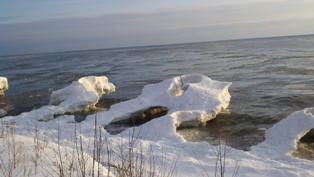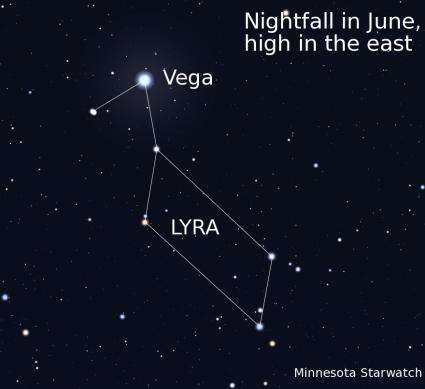The Big Freeze on Lake Superior: Where and When
| Attachment | Size |
|---|---|
| SuperiorIce_012711.mp3 | 13.16 MB |
Chel Anderson is a botanist and plant ecologist. She lives here in Cook County and joins us periodically to talk about phenology or what’s going on in the woods right now. Welcome back, Chel.
Anderson: Hi!
Well, this is the time of year when we start to speculate about how much ice there will be on Lake Superior. So, let’s talk about this and the impact that big lake ice has.
Anderson: With pleasure. I don’t know why, but ice on Lake Superior is incredibly exciting to me. So, I hope this isn’t overboard for those who aren’t that excited about winter in general, but I’ve lived here quite awhile now. I came up here in 1974 and, you know, during that time, we pretty much always have some ice on the shore by this time of the winter, but it’s really a fairly uncommon phenomenon on the lake, since I’ve been here, anyway, to have actual ice out on the open lake that makes it look like it’s iced over or, really rare, to have the lake actually freeze over. As we’ve talked about on a number of occasions, Lake Superior is a big heat sink. It absorbs warmth all during the spring, summer and fall and it does warm up, even though it’s not what we would call super swimmable most of the time. Because it’s such a huge mass of water, even if it’s only getting up to 40 degrees or 50 degrees in places, it takes a very long time for that heat to dissipate and get the water down to the point where it’s cold enough to freeze. So, this is a long process. So, it happens, ice forms out on the open lake and even in protected areas of Lake Superior much later than it does on our inland lakes. As we’ve talked also before, water out on Lake Superior, as everywhere else, as it cools down, when it gets to that 39 degree temperature, the water sinks into warmer water below, it’s replaced by warmer water, so that process has to go on and on and on until everything has cooled down to 39 degrees and the water is no longer sinking and being replaced by warmer water. And at that point, then the water at the surface can begin to go lower and actually get close to freezing and as that happens, and it can happen at different places and different times, because Lake Superior has shallow, more protected bays and those are going to be the first places that ice on the open lake is going to form. So, examples of that besides our harbor would be down by Duluth, up at Grand Portage bay, Thunder Bay. Those are places where you have big, shallow bays that are going to be some of the first places where ice will form on the open part of the lake. Then, elsewhere, once the surface water is actually staying colder than 39 degrees, wind becomes a huge factor in whether an ice sheet actually forms. So, the water can be down at 32 or even lower, but if we’ve got wind going on and it’s jostling it and moving it and creating waves and turbulence, just like a river, it’s not going to freeze into a sheet.
The lake is big, but it’s not affected, it does not have tides, but what is that phenomenon and does that keep the lake from freezing?
Anderson: Lake Superior does have a seiche and that can be affected by differences in barometric pressure over the different parts of the lake and it’s just a movement of water and certainly if there’s ice trying to be formed but you have any kind of an undulation, if it’s enough of an undulation, it’s going to prevent creating a sheet.
Well, I’ve been up here a couple of decades and in that period of time I’ve noticed there have been some flyovers of the lake. But, I can only remember a couple of times that it was reported that the lake was actually frozen over. What does it take to do that and does it freeze thick?
Anderson: Yes, it’s been very rare for the lake to completely freeze over, and, of course, we know it not by our own empirical experience, we can’t get up on a ridge and tell, but there’s satellite imagery that’s been available for decades now and you can actually go on the web and look at NOA’s Great Lakes Ice Atlas and you can actually look at charts of winters from the 1970s up until 2003 where they’ve taken those images and they’ve then made a chart that shows the great lakes and shows the maximum ice cover for a given year. So, the ice is going to be variable in thickness, even in a year like that. But, it’s going to have a lot of areas with very thick ice, because in order to be durable out on the open lake, ice has to be thick. Once an ice sheet forms out from our shore here, whether it survives very long or not is really dependent on the weather right then. Our ice usually forms on a cold, still night. Even if we don’t get those sheets of ice that last very long, even just having the ice form and then be moved around by the waves creates all this interesting dimension to the shoreline that we don’t see at other times of the year.
There’s a phenomenon that I’ve noticed that doesn’t seem to be too related to waves, but just in the general motion of the lake, when ice that’s, you know, less than an inch or maybe an inch, at the most, thick, starts to move into shore and slide up over itself and creates an incredible sounds and it’s an amazing experience.
Anderson: I agree totally. It’s just an incredibly inspiring and intriguing phenomenon. Both the sounds, as you say, if it’s really thin ice and it’s just starting to break up, it has this really light—what’s the name of that instrument that has the—the glockenspiel! It has that tone, just this beautiful light, clear tone, of small, bright sounds that come out of the ice. But, if it’s a thick sheet of ice that’s either formed on our shore or formed somewhere else and blown over here, but if one forms here or elsewhere and it comes to our shore when it can be pushed along by the wind and actually grind its way, both either right up, like you’re talking about, on to the shore or along the shore, but they’re grinding away on the bedrock as they go, and that’s a really good example of how lake ice plays a huge role as a disturbance factor on our bedrock shores.
Is there any difference in the character or quality of the ice on this side of Lake Superior as opposed to the other side?
Anderson: Big sheets of ice form more frequently and earlier in the year in other parts of the lake where the character of the lake is generally shallower. That’s why often the first ice sheets we see come from someplace else on the lake, could be the south shore, might be the east side of the lake, where there are big areas that are shallower and they can be very thick when they get here and they come ramming up on the shore.
Chel Anderson, botanist and plant ecologist. Thanks again for helping us understand this time what’s going on with ice on the big lake.
Anderson: Always a pleasure.
Tweet







